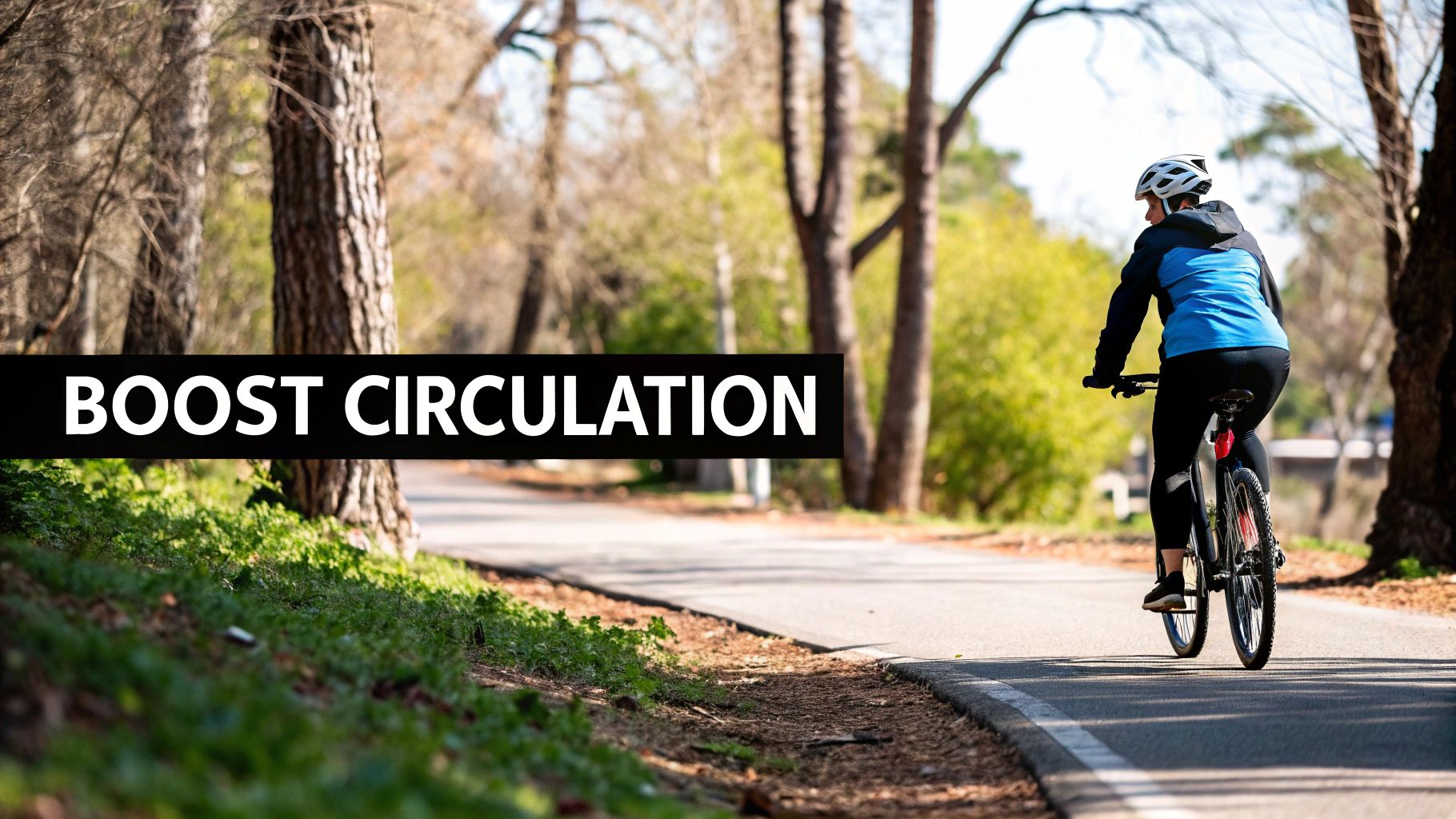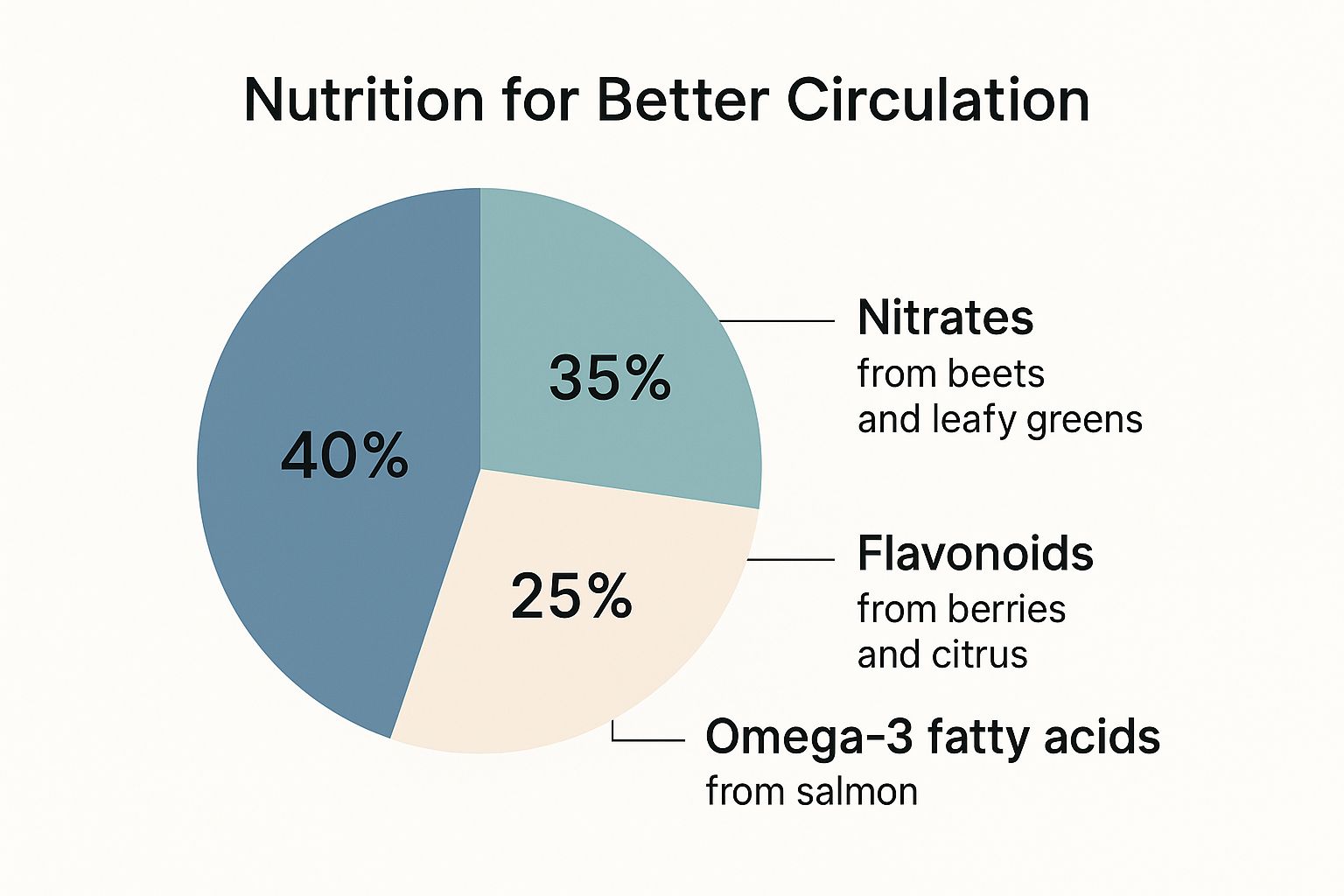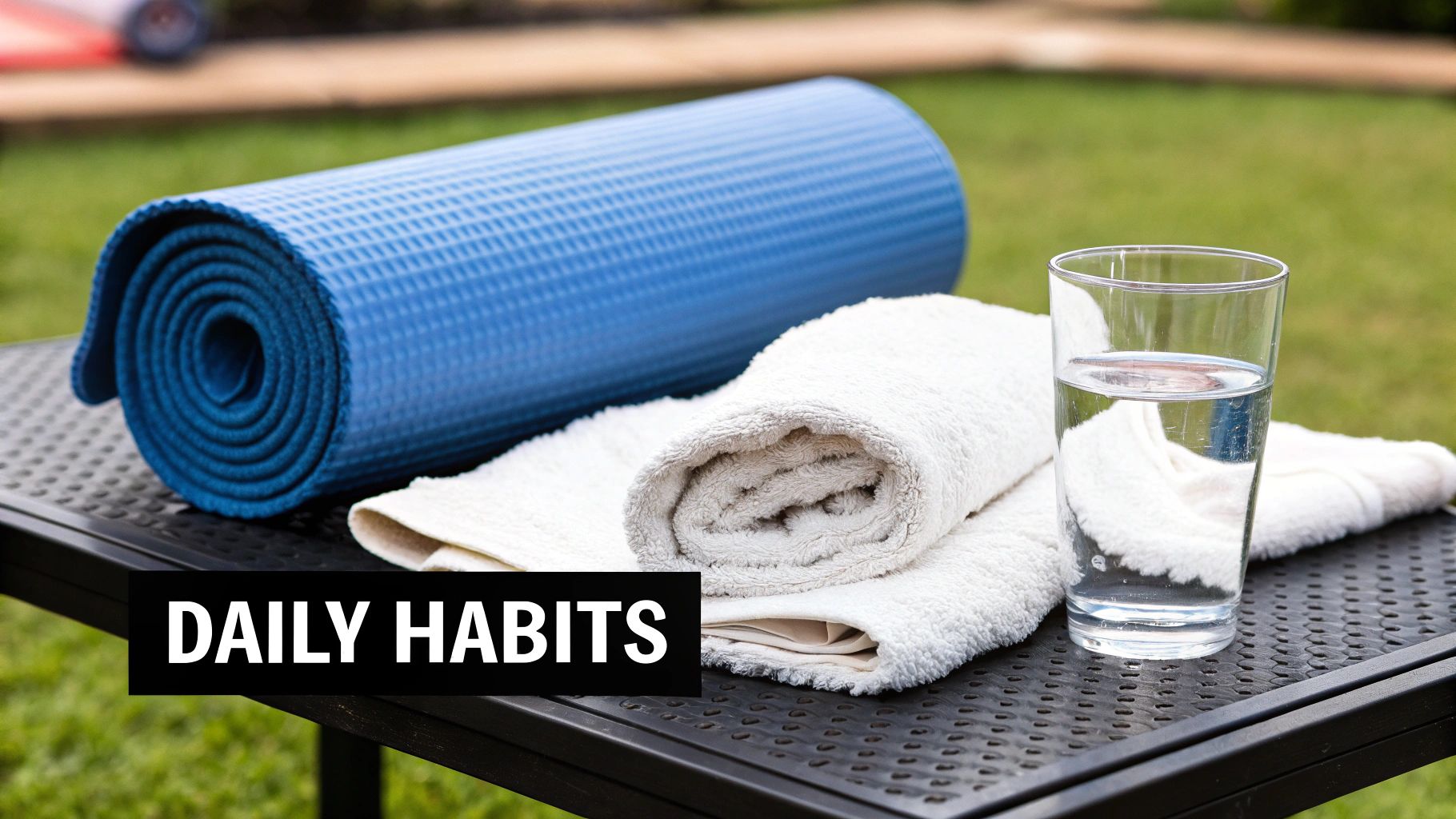When we talk about improving blood circulation naturally, it’s really a full-body commitment. It’s about weaving together smart lifestyle choices—like consistent exercise, eating foods that nourish your blood vessels, and staying properly hydrated. Even small daily habits, like taking breaks to move around or managing stress, are crucial for getting your blood pumping the way it should and supporting your long-term health.
What Poor Circulation Means for Your Health

Picture your circulatory system as your body's own internal highway. This massive network, stretching over 60,000 miles, is in charge of delivering everything—oxygen, nutrients, hormones—to every last cell. At the same time, it’s hauling away waste products. When this system is running smoothly, you feel fantastic.
But what happens when there's a traffic jam? That's essentially poor circulation. It isn't a disease in itself, but it's a huge red flag that something else is going on. It means that parts of your body, usually the furthest points like your hands and feet, aren't getting the oxygen-rich blood they need to function properly.
Recognizing the Subtle Signs
The tricky thing about poor circulation is that the symptoms often creep up on you. They can be easy to brush off as just being tired or feeling a bit off. Learning to spot these early warnings is the first real step toward figuring out the root cause and improving your blood flow.
Here are some of the common things I see in my practice:
- Tingling or Numbness: That classic "pins and needles" sensation, especially in your hands, feet, arms, or legs.
- Cold Hands and Feet: Do you constantly have icy fingers and toes, even when the room is warm? That's a tell-tale sign.
- Swelling in Lower Extremities: Medically known as edema, this happens when fluid pools in your legs, ankles, and feet because your circulation is too sluggish to move it along.
- Persistent Fatigue: When your organs and muscles are starved for oxygen, your energy levels can totally tank, leaving you feeling exhausted for no obvious reason.
- Muscle Cramps and Joint Pain: A lack of blood flow can lead to aching, throbbing, or cramping, particularly in the legs, calves, and feet.
Why It Impacts More Than Just Your Limbs
Ignoring these signals can create a ripple effect across your entire body. Sluggish blood flow can mess with everything from your brain function—causing memory fog or trouble concentrating—to the health of your skin, which might become dry, discolored, or slow to heal.
Your circulatory health is directly tied to your overall vitality. When blood flow is compromised, it can weaken your immune response, slow down wound healing, and even contribute to more significant health concerns over time.
For instance, poor circulation is a well-known factor in varicose veins and can even be connected to issues like erectile dysfunction. You can learn more about this specific connection in our detailed guide on natural approaches to erectile dysfunction. Understanding how everything is linked gives you the power to take proactive steps for your health.
Energize Your Body with Circulation-Boosting Exercises

If you really want to get your blood moving, you have to get your body moving. It’s that simple. Think of movement as the engine for your circulatory system—it helps your heart pump blood more efficiently and pushes it through that vast network of vessels.
This isn't about pushing yourself through grueling, high-intensity workouts. It’s about finding sustainable activities that feel good and energize you from the inside out.
Regular cardiovascular exercise is the absolute cornerstone of a healthy circulatory system. Things like brisk walking, swimming, or cycling are fantastic because they strengthen your heart muscle itself. A stronger heart doesn't have to work nearly as hard to pump blood, which improves flow everywhere in your body.
Try to aim for about 30 minutes of moderate activity on most days of the week, in line with recommendations from the American Heart Association. That could look like a crisp morning walk before work, an evening bike ride with the family, or a few laps in the pool. Consistency, not intensity, is what truly matters here.
Smart Movements for Sedentary Days
Let's be honest—many of us spend hours glued to a desk. This prolonged inactivity is one of the biggest culprits behind sluggish circulation, especially in the lower legs. Thankfully, you can counteract this with small, targeted movements you can do just about anywhere, even during a conference call.
These micro-movements are surprisingly effective:
- Ankle Pumps: Simply point your toes away from you, then flex them back toward your shins. Repeating this 10-15 times every hour or so activates your calf muscles, helping to push blood upward.
- Calf Raises: While standing, rise up onto the balls of your feet, hold for a beat, and then lower your heels back down. This is a powerful way to engage the "second heart" in your legs.
- Desk Stretches: Gently rotate your ankles in circles, both clockwise and counter-clockwise. This keeps the joints mobile and the blood flowing freely.
These simple actions prevent blood from pooling in your lower legs and can make a huge difference in how your legs feel by the end of the day. They prove you don't need a gym to figure out how to improve blood circulation.
Harnessing Gravity and Motion
Beyond traditional cardio, certain practices use gravity and specific postures to give your circulation a boost. Yoga, for instance, is brilliant for this. Poses like Downward-Facing Dog elevate your hips above your heart, encouraging blood to flow away from your feet and legs, which can help reduce swelling.
The real goal is to integrate movement into your lifestyle, not just schedule it as a task. Every step, stretch, and conscious posture contributes to a healthier, more dynamic circulatory system.
Even modern therapies confirm the power of motion. Take whole-body vibration (WBV), which uses mechanical stimulation to boost local circulation. Research actually shows that WBV can significantly increase skin blood flow, demonstrating how physical movement directly energizes your circulatory pathways. You can dive into the full study about these circulatory therapy findings.
By finding enjoyable ways to move your body every single day, you’re taking one of the most powerful steps toward lasting circulatory health.
Eat Your Way to Better Blood Flow
The food on your plate has a powerful, direct impact on the health of your entire circulatory system. In fact, every meal is an opportunity to either support or hinder the complex network of your 60,000 miles of blood vessels. Choosing the right foods can help keep these pathways flexible, clear, and efficient.
This isn't about restrictive dieting; it's about making smart additions. By understanding which nutrients make the biggest difference, you can build a practical, circulation-friendly eating plan that nourishes your body from the inside out and helps improve blood circulation naturally.
Powerhouse Nutrients for Your Arteries
Certain nutrients are simply exceptional at supporting blood vessel health. Nitrates, for example, are converted in the body to nitric oxide, a fantastic molecule that helps your blood vessels relax and widen, allowing blood to flow much more easily. You'll find these in abundance in foods like beets and leafy greens such as spinach and arugula.
Another key group is flavonoid antioxidants. Think of them as your vessels' personal bodyguards. They help protect the delicate lining of your arteries from damage caused by inflammation and free radicals. You can load up on these by eating colorful berries, citrus fruits, and even a small amount of dark chocolate.
Finally, omega-3 fatty acids are essential for reducing systemic inflammation, which is a major contributor to poor circulation. Fatty fish like salmon, mackerel, and sardines are some of the very best sources. Just consuming them a couple of times a week can make a significant difference.
This infographic breaks down how these key nutrients contribute to a diet that boosts circulation.

As you can see, a balanced approach that emphasizes plant-based nitrates and flavonoids while incorporating healthy fats provides a strong foundation for circulatory health.
Your Circulation-Friendly Shopping List
To make things simple, I've put together a quick-reference table to help you stock your kitchen with foods that actively promote better blood flow.
Foods to Boost Your Blood Circulation
This simple guide breaks down the best foods for improving blood flow, categorized by their primary beneficial nutrient.
| Food Category | Examples | How It Helps Circulation |
|---|---|---|
| Nitrate-Rich Vegetables | Beets, spinach, kale, arugula, Swiss chard | Convert to nitric oxide, which helps relax and widen blood vessels for better flow. |
| Flavonoid-Rich Fruits | Berries (blueberries, strawberries), citrus (oranges, grapefruit), pomegranates | Act as powerful antioxidants that protect blood vessel linings from damage and inflammation. |
| Omega-3 Fatty Acids | Fatty fish (salmon, mackerel, sardines), walnuts, flaxseeds, chia seeds | Reduce inflammation throughout the body, which can otherwise constrict blood vessels. |
| Antioxidant Vegetables | Broccoli, cauliflower, garlic, onions | Help combat oxidative stress and support the overall health and flexibility of arteries. |
By building your meals around these whole, nutrient-dense foods, you're making a conscious choice to support your circulatory system every single day.
Of course, what you don't eat is just as important. Excess salt, for instance, can lead to water retention and increased blood pressure, putting a real strain on your arteries. Finding ways to reduce your intake is a crucial step. For practical tips, check out our helpful low-sodium foods chart to make smarter choices.
Likewise, excessive sugar and highly processed foods can increase inflammation, working directly against your circulation goals. It's all about balance and making more good choices than bad ones.
Simple Lifestyle Habits for Lasting Circulatory Health

While your diet and exercise routines are the big players in circulatory health, it's the small, consistent habits you weave into your day that truly build a strong foundation for the long haul. These simple lifestyle tweaks can have a surprisingly profound effect on how easily your blood flows, impacting everything from your daily energy to your future well-being.
One of the most overlooked factors is hydration. It sounds simple, but when you're dehydrated, your blood volume actually decreases. This makes it thicker and stickier, forcing your heart to work much harder to pump it around. Just making sure you drink enough water throughout the day is a game-changer for maintaining optimal blood viscosity, letting it move freely through your veins and arteries.
Manage Stress to Relax Your Blood Vessels
It’s no secret that chronic stress is a wrecking ball for your health, but its impact on circulation is very direct and physical. When you’re stressed, your body goes into "fight or flight" mode, releasing hormones like cortisol and adrenaline. These hormones cause your blood vessels to constrict and narrow.
This constant tightening forces your heart to pump against resistance, raising your blood pressure and slowing down flow. Over time, this state of tension can even damage the delicate inner lining of your arteries. Finding effective ways to manage stress isn't just a nice idea—it's absolutely essential for a healthy circulatory system.
A few simple practices can make a world of difference:
- Mindful Breathing: Just five minutes of slow, deep belly breathing can calm your nervous system and help lower your blood pressure.
- Time in Nature: Stepping outside, even for a short walk, has been proven to lower cortisol levels and create a sense of calm.
- Gentle Movement: Activities like yoga or tai chi are brilliant because they combine physical movement with a meditative focus, hitting the reset button on stress.
Managing stress is a powerful tool for improving blood circulation. When you relax your mind, you give your blood vessels the signal to relax as well, creating more space for blood to flow efficiently.
Chronic high blood pressure is a massive health problem in the United States. According to the CDC, nearly half of American adults have hypertension, and only about one in four has it under control. This condition directly damages blood vessels and sabotages the efficiency of blood flow, which significantly increases health risks. For a deeper dive, check out this report on hypertension from the CDC.
Simple At-Home Circulation Boosters
You don't need any fancy equipment to give your blood flow a boost right at home. One of my favorite techniques is the contrast shower. By alternating between hot and cold water, you encourage your blood vessels to rapidly expand and then contract.
This "pumping" action is like a workout for your arteries and can significantly improve circulation, especially to your hands, feet, and skin. A great way to start is with three minutes of hot water, then one minute of cold. Repeat that cycle three times, always making sure to end on cold. It's an incredibly invigorating way to start your day and support your entire circulatory system.
For those already keeping an eye on their blood pressure, our guide on natural ways to lower blood pressure offers even more strategies that work beautifully alongside these daily habits.
When Natural Approaches Aren't Enough
Making positive lifestyle changes is a fantastic starting point for improving blood circulation. But it’s crucial to know when those efforts just aren't cutting it on their own.
Sometimes, poor circulation isn’t simply a lifestyle issue—it’s your body’s way of signaling a more serious, underlying medical condition that needs a professional eye.
Ignoring persistent symptoms can lead to very real health problems down the road. Your body is smart, and it sends clear signals when something deeper is going on. Listening to these warnings is probably the most important thing you can do for your long-term health. Knowing the difference between minor sluggishness and a serious red flag is vital.
Critical Red Flags You Should Never Ignore
While having cold feet or occasional tingling can often be managed at home, certain symptoms demand immediate medical attention. If you’re experiencing any of the following, it’s time to stop the self-treatment and get in touch with your doctor right away.
These are not the kind of signs you want to "wait and see" on:
- Sores That Don't Heal: Any ulcer or sore that refuses to heal, especially on your legs, ankles, or feet, is a major warning sign of severely compromised blood flow.
- Skin Discoloration: If you notice your skin turning unusually pale, blue, or developing a blotchy, mottled pattern, it can mean a serious lack of oxygenated blood is reaching that area.
- Sudden or Severe Pain: Sharp, cramping pain in your legs that flares up with activity (this is known as claudication) or any sudden, unexplained limb pain needs to be evaluated immediately.
- Loss of Sensation: Complete numbness or being unable to feel hot or cold in a hand or foot is a very serious signal.
Seeking a professional diagnosis is the most crucial action you can take. Treating just the symptoms without understanding the root cause is like patching a leak without fixing the broken pipe—it won't solve the underlying problem.
The Importance of an Accurate Diagnosis
Poor circulation can be a primary symptom of conditions like Peripheral Artery Disease (PAD), where plaque buildup narrows your arteries, or uncontrolled diabetes, which damages blood vessels over time. It could also point to issues like blood clots or Raynaud's disease. Only an accurate diagnosis can ensure you get the right treatment for the actual root cause.
In a medical setting, the importance of properly managed blood flow is crystal clear. For example, a major analysis of surgical patients showed that protocols designed to optimize circulation dramatically cut the risk of serious complications like renal failure and infections. You can read more about these clinical benefits of targeted blood flow management. This just goes to show that when circulation is seriously compromised, professional intervention is absolutely critical to protect your overall health.
Common Questions About Improving Circulation
As you start making changes to boost your circulation, it's completely normal to have a few questions. The path to better circulatory health can feel a bit complex, but getting clear, straightforward answers makes all the difference. Let's tackle some of the most common questions we hear to help you move forward with confidence.
A lot of people want to know if their efforts are actually paying off. The good news is, your body often gives you little signals sooner than you might think.
How Long Does It Take to Improve Blood Circulation?
There isn't a one-size-fits-all answer here, as your starting point and how consistent you are with new habits play a huge role. That said, many people begin to notice small, encouraging changes within just a few weeks of making lifestyle adjustments. This could be something as simple as warmer hands and feet, or realizing you don't get that tingling "pins and needles" sensation as often.
For more significant improvements, like measurable changes in your blood pressure or less swelling in your ankles, you're typically looking at a few months of dedicated effort. The key is to see this as a long-term commitment to your health. Focus on sustainable daily habits instead of searching for a quick, temporary fix.
Are Supplements for Blood Flow Worth It?
This is a big question, and the answer comes with a bit of caution. While certain supplements—like omega-3s, ginkgo biloba, and L-arginine—have shown some promise in studies, they are absolutely not a substitute for a healthy diet and an active lifestyle. In the United States, the supplement industry is not tightly regulated by the FDA, meaning the quality and potency of products can vary dramatically.
A food-first approach is always the safest and most effective starting point for improving your health. Nutrients from whole foods are more easily absorbed and come packaged with other beneficial compounds that work together synergistically.
Before you start any new supplement, always talk to your doctor. They can interact with medications you're already taking and might not be suitable for your specific health situation.
Do Compression Socks Actually Help Circulation?
Yes, for many people, compression socks can be an incredibly helpful tool. They work by applying gentle, graduated pressure to your legs, which helps your veins and leg muscles move blood more efficiently back up toward your heart. It's a simple mechanism, but it’s highly effective at preventing blood from pooling in your lower legs.
They are especially useful for anyone who:
- Sits or stands for long periods at work.
- Travels on long flights or car rides.
- Is managing conditions like varicose veins or chronic swelling (edema).
By reducing swelling and giving your veins some extra support, they can make a real difference in comfort and circulatory efficiency. For the best results, it's always a good idea to ask your doctor what level of compression is right for you.
At Medilux Ayurveda USA, we blend ancient wisdom with modern care to support your circulatory health and overall wellness. Our personalized Ayurvedic protocols and expert consultations are designed to address the root cause of lifestyle disorders. Discover how our tailored treatment plans can help you achieve better balance and vitality. Learn more at https://mediluxayurveda.com.
